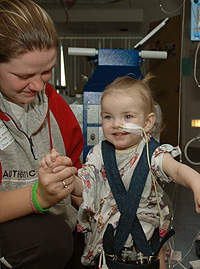 McKenzi Carmack's face has magical powers. When she widens her saucer-blue eyes to a full twinkle, and adds the toothy grin of an aspiring two-year-old, the forces mysteriously combine to draw people near her. They can't help it. Gazing into her eyes is enough to melt your heart. But gazing into her heart -- that was what really hurt.
McKenzi Carmack's face has magical powers. When she widens her saucer-blue eyes to a full twinkle, and adds the toothy grin of an aspiring two-year-old, the forces mysteriously combine to draw people near her. They can't help it. Gazing into her eyes is enough to melt your heart. But gazing into her heart -- that was what really hurt.
Shortly after birth, McKenzi was diagnosed with dilated cardiomyopathy, a degenerative and often fatal heart disease. By nine weeks of age, doctors had placed her on the heart transplant list. It wasn't until she was 17 months old that the disease began ravishing her small body at an alarming rate.
"Her system was just shutting down," said Shasta Carmack, McKenzi's mom. "Our doctors told us she'd die in a matter of hours if we didn't get help fast."
So the Carmacks brought McKenzi from Sperry, Oklahoma, a rural community about 40 miles outside Tulsa, to St. Louis Children's Hospital, where surgeons hoped to perform a heart transplant as soon as a suitable heart became available.
"It can take weeks, even months, to find a perfect match for a heart," explains pediatric cardio-thoracic surgeon Sanjiv Gandhi, MD. "With McKenzi, we didn't have that kind of time. If we didn't do something fast, we were going to lose her."
They found a temporary solution by placing McKenzi on an ECMO machine, which takes over for the failing heart and circulates the blood throughout the body. But ECMO also requires the patient be on a breathing machine, and doesn't allow the patient to move around. It keeps the patient alive, but it's debilitating and exhausting for the body. McKenzi was not likely to last on ECMO for a prolonged period of time.
She needed something to keep her heart going until a transplant became available. Implantable heart pumps called ventricular assist devices do exist for adult patients as a 'bridge' to transplant. But there is nothing available in the US for infants or small children. So McKenzi's doctors found their solution overseas.
They applied for special clearances from the medical review board at St. Louis Children's Hospital and the Food and Drug Administration to use a device developed in Germany called the Berlin Heart.
The device sits outside the body and is connected to the heart by multiple tubes. The device pumps blood through the patient’s body to the vital organs. It prolongs the time a patient can wait for a heart transplant and is the only device available for small children who are at risk for heart failure.
Doctors were successful with their appeals. McKenzi was one of a dozen American babies to receive the Berlin Heart, and the first in the state of Missouri.
MacKenzi lived with the Berlin Heart for almost 2 months. "The pumps acted as a substitute for MacKenzi’s own ventricles, or pumping chambers," explained Dr. Gandhi. "It did all the work for McKenzi's heart, without causing a workout for her little body."
Shasta was amazed at how McKenzi was able to breathe and eat on her own while on the pump. "She started gaining weight and started walking and moving around, things she wasn't able to do before she was on it."
By the time a heart did become available, McKenzi was in excellent condition. "The transplant went so much more smoothly because McKenzi was in good shape," says Dr. Gandhi. "She was strong, her organs had bounced back. She was otherwise very healthy."
Just 10 days after the transplant and it was already time for McKenzi to leave St. Louis Children's Hospital. "She's really taking off on eating, walking and playing," says Shasta. "She's getting back to normal."
Inspired by McKenzi's success and speedy recovery, Dr. Gandhi is fighting to bring the device to the U.S., to make the option available to cardiothoracic surgeons treating small patients.
"The thing about McKenzi is nobody expected her to live," says Dr. Gandhi. "At one point we had a pretty frank conversation with mom and dad that they should probably be prepared for the worst and that McKenzi was probably going to heaven. But this pump saved her life."










